Agronomy Update: Agronomists Emphasize Scouting for Stalk Integrity
BY DAIRYLAND SEED AGRONOMY TEAM
Stressed Corn Due To Dry Weather Should be Scouted for Stalk Integrity
With corn harvest soon upon us, it is especially important this year that we spend time scouting our corn fields and prioritizing which fields need to be harvested first and which ones can wait. In many areas, corn stalk integrity may be compromised from cannibalization of the stalk caused from very dry conditions. In addition, cannibalization of the stalk predisposes the weakened corn plant to stalk and crown rots. Knowing what fields need harvesting first, may save a lot of headaches later.
The procedure that I follow to check fields is to review which fields were planted in “less than ideal conditions” as well as shorter day hybrids and scout them first. I will then walk across a portion of the field and perform Pinch, Push, Shove and Slash tests along the way looking at both green healthy plants and also plants that are yellow/tan and or stunted:
- Pinch the stalks 4-8” off the soil level. If it collapses, you have a crown or stalk rot, or both.
- Push the stalks so the top of the corn plant touches the row across from it. If it buckles under that pressure, odds are you have a stalk rot.
- Shove a few stalks down the row and see how much pressure it takes to break them. The less pressure it takes to break them, increases the probability of standability issues.
- Slash or cut the stalk 10-12” above the soil line with a sharp knife down to or through the roots. (Remember to be safe and cut away from yourself.) I generally dig the plant first. The crown and stalk should be a white or creamy color. The photo below shows a healthy stalk and root on the left. Whereas, the stalk and root on the right is not healthy. If it is not, that plant has a crown or stalk rot.
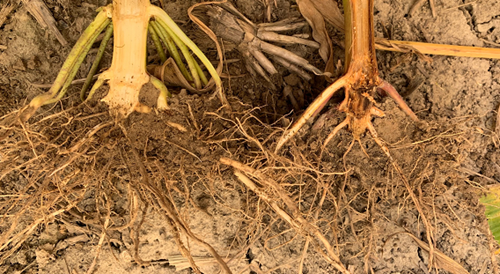
The more plants that fail these tests, increases the odds that you will need to harvest that field early or move it up in the harvest schedule. Remember that these affected plants will be more susceptible to wind damage, the longer the harvest window gets.
Having and following a harvest order decreases the likelihood of harvesting down corn, and increases the likelihood of capturing more yield but also having a safer and less stressful harvest season.
Late Season Bean Leaf Feeding
As Dairyland Seed agronomists made their travels through grower fields and plots last week, they noticed holes in soybean leaves. Upon further inspection and investigation, they found evidence of Bean Leaf Beetle (BLB) feeding. Typically, we can see late season BLB feeding, but not to the extent observed in certain fields.
BLB over winter as adults and can be an issue with beans early in the season. As vegetative growth increases, the possibility of reaching damage thresholds from leaf feeding decreases. However, under certain conditions, we can get serious levels of feeding. Look for feeding holes in the leaf resembling buckshot. If the feeding level is at roughly 25 percent defoliation, it may warrant treating if soybeans are at R6 (full pod at the uppermost node) or less and beetle levels are increasing.
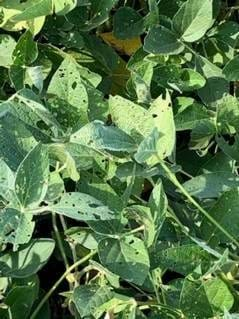
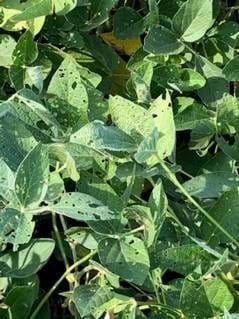
Given the stage of soybean development at this time of year, there exists little economic benefit to treating for leaf feeding. However, the more concerning damage is potential pod feeding and damage to the underlying soybean seed. The pod feeding resembles white blotches where the outer layer of the pod has been fed upon. See photo below.
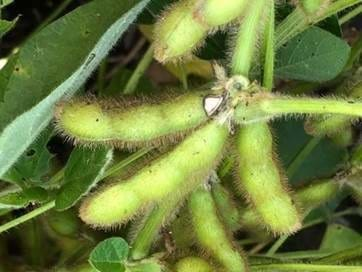
These open “wounds” on the pod leaves the pod and soybeans more susceptible to molds and rots. Soybean pod mottle virus is another issue with BLB feeding. The beetles vector the disease to the soybean seed through the pod and cause discoloration and damage. Treatment may be justified depending upon number of beetles and level of pod feeding. For specifics I would refer to https://extension.entm.purdue.edu/fieldcropsipm/insects/bean-leaf-beetle.php
Soybean Harvest Yield Loss
Soybean yield loss at harvest can be a result of either delayed harvest issues (shattering, lodging, etc.) and/or mechanical losses from the combine. With a 12” x 12” square, you can categorize how much yield you are leaving in the field.
Michigan State University recommends that we target three percent or less yield loss from mechanical harvest. If we consider that four beans laying on the ground per square foot is equal to roughly one bu/acre yield loss, we want to see less than six beans per square foot in a 50 bu/acre field (Figure 1). Generally, mechanical yield loss is the number of beans on the ground after the harvester minus the number of beans already on the ground before the harvester. Here is how you can drill in deeper:
- Stop the combine in the middle of a pass and back out after the machine has cleared out.
- Toss your square on the ground in the following areas and count the beans inside it. Do this at least three times in each area to get an average.
- Ahead of the combine in unharvested crop: The number of beans on the ground is the shatter loss. Include beans that were in dropped pods. If beans are shattering or lodging ahead of your combine pass, it’s a harvest timing issue in most cases.
- Under the machine to capture header losses
- Stubble count: the number of beans in pods still attached to the cut stubble. They were too low to the ground for the header to cut and pick up.
- Escaped plant count: the number of beans on plants that were cut but not gathered by the head. Are stems too wet? Are reel settings tuned?
- Lodged count: the number of beans on plants that were not cut by the header.
- Loose bean count: now the total of header shatter and environmental shatter.
- Behind the machine loose bean count: now the total of environmental shatter, header shatter and threshing loss. Avoid the chaff pile from when you stopped.
- Do some math and adjust. Remember that 4 beans per square foot is ~ 1bu/Ac.
- Note that remedies for individual issues are listed above.
- Thresher Loss = 2.c – 2.b.iv. Consult manufacturer resources to optimize thresher settings.
- Total Mechanical Loss = header loss + thresher loss = (2.b – 2.a) + 3.b. Target 3% of yield.
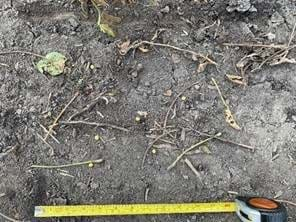
Figure 1. Six loose beans in 1 square foot
Corteva Technology Use Agreements
All growers with orders for any Corteva Agriscience brand seed product, regardless of crop or trait (including non-GM products) need to have a signed Corteva Technology Use Agreement in place by September 1. Growers should sign the Corteva Technology Use Agreement electronically at www.agcelerate.com. Signing electronically is preferable, however, paper copies are available at www.traitstewardship.com.
 |
 |
 |
 |
 |
| Brian Weller Western Region 507.456.3034 |
Dan Ritter Central Region 219.863.0583 |
Branden Furseth Northern Region 608.513.4265 |
Rod King Eastern Region 574.596.6721 |
Terry Jones Eastern Region 419.630.3115 |
